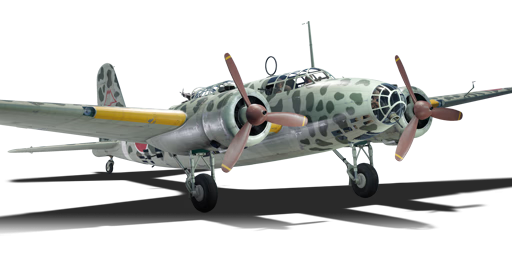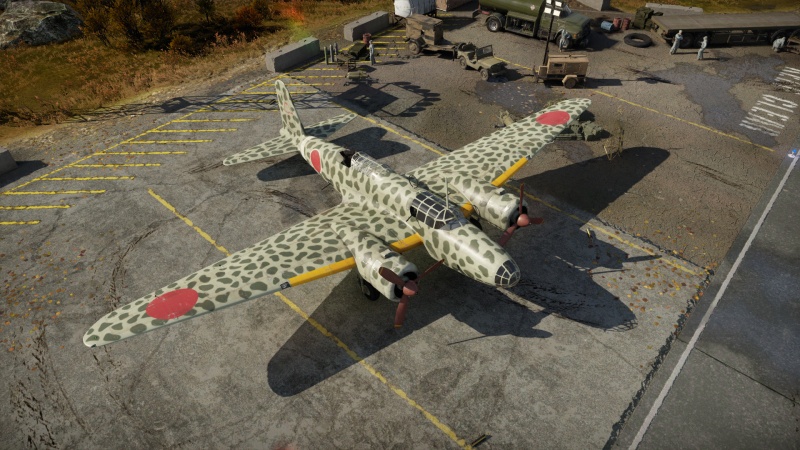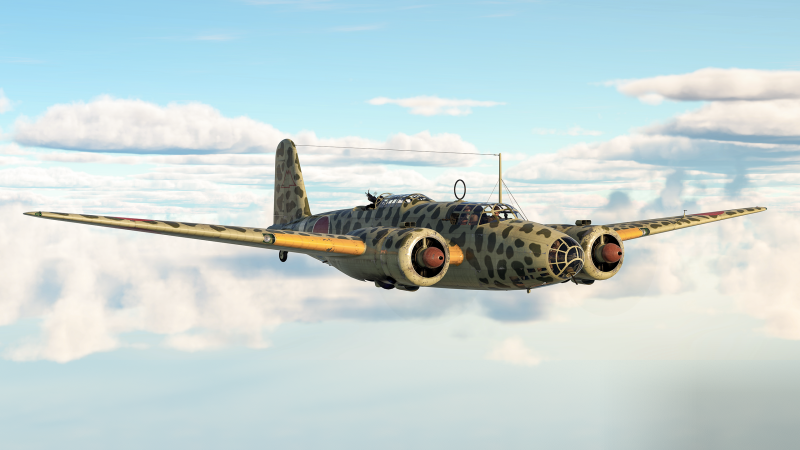Difference between revisions of "Ki-21-I hei"
bettafishboi (talk | contribs) (→Flight performance) |
Colok76286 (talk | contribs) (Undo revision 153111 by U129520443 (talk)) |
||
| Line 83: | Line 83: | ||
!WEP Engine power | !WEP Engine power | ||
|- | |- | ||
| − | |3,700 m||890 hp||1, | + | |3,700 m||890 hp||1,080 hp |
|} | |} | ||
Revision as of 23:29, 30 January 2023
| This page is about the gift Japanese bomber Ki-21-I hei. For the regular version, see Ki-21-Ia. |
Contents
Description
The Ki-21-I hei is a gift rank II Japanese medium bomber with a battle rating of 2.3 (AB), 2.0 (RB), and 1.7 (SB). It was introduced during Update 1.65 "Way of the Samurai" as a reward vehicle for the 2016 "Winter Holiday" event. It was later made available as a battle trophy vehicle in the Warbond shop from the Battle Pass: Season I, 75th Anniversary of the Great Victory until the end of the Battle Pass: Season IV, "Fearless Voltigeur".
General info
Flight performance
| Characteristics | Max Speed (km/h at 400 m) |
Max altitude (metres) |
Turn time (seconds) |
Rate of climb (metres/second) |
Take-off run (metres) | |||
|---|---|---|---|---|---|---|---|---|
| AB | RB | AB | RB | AB | RB | |||
| Stock | 413 | 400 | 8600 | 14.7 | 15.3 | 3.1 | 3.1 | 600 |
| Upgraded | 453 | 432 | 13.6 | 14.0 | 9.8 | 5.9 | ||
Details
| Features | ||||
|---|---|---|---|---|
| Combat flaps | Take-off flaps | Landing flaps | Air brakes | Arrestor gear |
| ✓ | ✓ | ✓ | X | X |
| Limits | ||||||
|---|---|---|---|---|---|---|
| Wings (km/h) | Gear (km/h) | Flaps (km/h) | Max Static G | |||
| Combat | Take-off | Landing | + | - | ||
| 540 | 380 | 428 | 399 | 250 | ~7 | ~2 |
| Optimal velocities (km/h) | |||
|---|---|---|---|
| Ailerons | Rudder | Elevators | Radiator |
| < 260 | < 260 | < 260 | > 320 |
| Compressor (RB/SB) | ||
|---|---|---|
| Setting 1 | ||
| Optimal altitude | 100% Engine power | WEP Engine power |
| 3,700 m | 890 hp | 1,080 hp |
Survivability and armour
- No armour
- Self-sealing fuel tanks (2 in each wing, 2 in the mid-fuselage)
Modifications and economy
Armaments
Suspended armament
The Ki-21-I hei can be outfitted with the following ordnance:
- 20 x 50 kg Army Type 94 GPHE bombs (1,000 kg total)
- 10 x 100 kg Army Type 94 GPHE bombs (1,000 kg total)
- 4 x 250 kg Army Type 92 GPHE bombs (1,000 kg total)
- 2 x 500 kg Army Type 92 GPHE bombs (1,000 kg total)
Defensive armament
The Ki-21-I hei is defended by:
- 2 x 7.7 mm Type 89 'special' machine guns, dorsal turret (450 rpg = 900 total)
- 1 x 7.7 mm Te-1 machine gun, nose turret (483 rpg)
- 1 x 7.7 mm Te-1 machine gun, 2 x cockpit turrets (483 rpg)
- 1 x 7.7 mm Te-1 machine gun, 2 x beam turrets (483 rpg)
- 1 x 7.7 mm Te-1 machine gun, ventral turret (483 rpg)
- 1 x 7.7 mm Te-1 machine gun, tail turret (483 rpg)
Usage in battles
The main difference between the Ki-21-Ia and this Ki-21-Ic is armament, 2 x Te-1s compared to 7 x Te-1s which are simply the best 7.7 mm Japan can offer, with a rate of fire of 950 rpm, API - IT belts in the universal belt which do a lot of damage and covers the whole plane.
If attacked by fighters, it is important to remember and recognize the Ki-21's turning capabilities. It is actually possible to win lateral turn fights against fighters with this aircraft as she is one of the most manoeuvrable bombers if not the most manoeuvrable bomber in game.
This aircraft has the ability to hold up to 1,000 kg of bombs in several different variations: 20 x 50 kg, 10 x 100 kg, 4x 250 kg, and 2 x 500 kg. Use the 20 x 50 kg or 10 x 100 kg bombs to attack light tanks and light pillboxes. They are not viable against bigger targets, since direct hits are needed to destroy. This loadout is particularly useful on maps that have an abundance of non-moving targets (light pillboxes) or lightly armoured targets (armoured cars or AA trucks for example). Use either of the 4 x 250 kg or 2 x 500 kg payload to destroy heavier targets such as medium tanks, pillboxes, destroyers, and cargo ships.
Although unconventional, this aircraft is a fantastic weapon if you want to bait the enemy. Ideally, you would want to attract a higher flying enemy down to you and to get into a turn fight. This way, depending on the enemy aircraft you can out manoeuvre and distract him while teammates fly down to finish him off.
Manual Engine Control
| MEC elements | ||||||
|---|---|---|---|---|---|---|
| Mixer | Pitch | Radiator | Supercharger | Turbocharger | ||
| Oil | Water | Type | ||||
| Not controllable | Controllable Not auto controlled |
Controllable Auto control available |
Controllable Auto control available |
Separate | Not controllable 1 gear |
Not controllable |
Pros and cons
Pros:
- Very manoeuvrable
- Extensive bombload for a rank I Japanese bomber
- Decent cruising speed
- Durable, can take some hits
- Above average defensive armament for its BR
- Internal payload
Cons:
- Loses effectiveness with altitude
- No armour
- Falls quickly when attacked by multiple foes
- Head-on attacks are usually fatal because of lack of protection for the pilots
- Gunners can be knocked out easily
History
About the plane
The first-generation Ki-21, or Ki-21-I Kô (Model IA), was a full-metal monoplane bomber. Its cantilever wing was implanted in the middle position. The crew positions were largely glazed, providing good visibility for the five crewmen. The landing gear included two train legs fitting almost completely into the two engine nacelles, plus a non-retractable tailwheel. The two engines were Nakajima Ha-5 Kai, with unit power of 850 hp (1,000 hp at takeoff), each driving a three-bladed metal propeller with variable pitch. Serial production really began in 1938 in the Mitsubishi and Nakajima factories.
Combat usage
The first available aircraft were engaged in China during Summer 1938, where they were well-received by the crews of the army. The first reports on the commitment of these planes enabled Mitsubishi to make changes, particularly in terms of armaments. This led to the development of new versions, such as Ki-21-Ib (乙, otsu) and finally Ki-21-Ic (丙, hei).
Media
- Skins
See also
Links to the articles on the War Thunder Wiki that you think will be useful for the reader, for example:
- reference to the series of the aircraft;
- links to approximate analogues of other nations and research trees.
External links
| Mitsubishi Company (三菱商会) | |
|---|---|
| Fighters | A5M4 · Hagiri's A5M4 |
| A6M2 mod. 11 · A6M2 · A6M3 · A6M3 mod. 22 · A6M3 mod. 22Ko · A6M5 · A6M5 Ko · A6M5 otsu · A6M5 Hei · A6M6c | |
| A7M1 (NK9H) · A7M2 | |
| J2M2 · J2M3 · J2M4 Kai · J2M5 · J2M5 (30 mm) | |
| Hydroplanes | F1M2 |
| Interceptors | Ki-83 · Ki-109 |
| Bombers | G4M1 |
| Ki-21-Ia · Ki-21-I hei · Ki-67-I Ko · Ki-67-I otsu | |
| Jet Fighters | Ki-200 |
| Captured | ▃A6M2 · ␗A6M2 |
| See also | Mitsubishi Heavy Industries, Ltd. (Post-War) |
| Japan bombers | |
|---|---|
| Navy | |
| Carrier-based attack bomber | |
| B5N | B5N2 |
| B6N | B6N1 · B6N2 · B6N2a |
| B7A | B7A2 · B7A2 (Homare 23) |
| Carrier-based dive bomber | |
| D3A | D3A1 |
| D4Y | D4Y1 · D4Y2 · D4Y3 Ko |
| Shipboard Observation seaplane | |
| F1M | F1M2 |
| Land-based Attack bomber | |
| G4M | G4M1 |
| G5N | G5N1 |
| G8N | G8N1 |
| Flying boat | |
| H6K | H6K4 |
| H8K | H8K2 · H8K3 |
| Land-based Bomber | |
| P1Y | P1Y1 |
| Army | |
| Light | Ki-32 |
| Ki-48-II otsu | |
| Heavy | Ki-21-Ia · Ki-21-I hei |
| Ki-49-I · Ki-49-IIa · Ki-49-IIb · Ki-49-IIb/L | |
| Ki-67-I Ko · Ki-67-I otsu | |
| Other countries | ▅B-17E |
| Japan premium aircraft | |
|---|---|
| Fighters | Hagiri's A5M4 · A7He1 · Ki-27 otsu Tachiarai |
| Ki-44-II otsu · ▅Bf 109 E-7 · ▅F4U-1A · Ki-100-II · Ki-44-I 34 | |
| ▅Fw 190 A-5 · A7M1 (NK9H) · Tada's Ki-61-I hei · ▅P-51C-11-NT | |
| J2M4 Kai · A6M5 Ko · A6M6c · J2M5 · Ki-87 · J6K1 | |
| Twin-engine fighters | Ki-96 |
| Jet fighters | F-86F-40 JASDF▅ · T-2 Early · F-4EJ ADTW |
| Strike aircraft | ▄AV-8S |
| Bombers | Ki-21-I hei · Ki-48-II otsu · H8K3 · B7A2 (Homare 23) · ▅B-17E |






